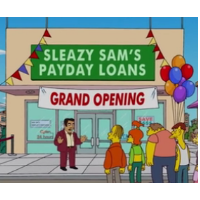State Lawmakers Keep Their Hands off Payday Lenders
 (graphic: The Simpsons)
(graphic: The Simpsons)
State lawmakers, weighing how one person’s “debt trap” is another person’s “safety net,” came down on the side of safety netters and killed legislation that would have reined in payday lenders who charge mostly poor people triple-digit interest rates on short-term loans.
Senate Bill 515 would have capped the number of these predatory loans that a customer could take out to four per year, established a database to track payday loans, allowed more time for loans to be repaid and limited the availability of a loan based on the borrower’s income.
But the Senate Banking and Financial Institutions Committee buried the legislation on a 5-3 vote.
Payday lender lobbyist Paul Gladfelty, expressing concern (“I do feel bad”) about people taking out loans they can’t afford at usurious rates, told lawmakers at a hearing before the vote on Wednesday that he objected to the loans being called a “debt trap.” He thought “safety net” was more applicable for the 1.6 million people who took out 12 million of the loans in 2011, according to the San Jose Mercury News.
Gladfelty also denied that the $3.6 billion industry’s store fronts, located mostly in poor communities, are targeting the minority residents who disproportionately live there. “If they are, it's coincidental, and it's not part of a coordinated strategy,” he said.
Payday loans are effectively banned in 15 states, where loans are capped under 36%. They are defended by their advocates as a last source of credit to people who often don’t have charge cards or bank accounts. Lenders characterize the loans, which can cost a borrower $45 to obtain $255 and result in effective interest rates of up to 460%, as emergency, occasional temporary fixes.
A 2007 study by the California Department of Corporations showed that payday borrowers tended to be repeat customers, rather than the one-time borrowers coping with an emergency often cited by the industry. Lenders reported that 48% of their business came from persons taking out between two and nine loans in an 18-month period. Nineteen percent took out 15 or more loans.
They say the only alternative for these desperate borrowers would be the internet, which is unregulated and even more dangerous. In 2011, 35% of payday loans were made online, and they totaled $13 billion. They are facilitated by big banks, like JP Morgan Chase, Bank of America and Wells Fargo, which allow lenders to withdraw money from borrowers’ bank accounts to cover payday loans.
–Ken Broder
To Learn More:
Payday Lenders Win Again in the State Legislature―No New Industry Curbs on Horizon (by Karen de Sá, San Jose Mercury News)
Hannah-Beth Jackson's Bill to Regulate Payday Lenders Stalls (by Timm Herdt, Ventura County Star)
2007 Payday Loan Study (California Department of Corporations) (pdf)
As States Ban Payday Loans, Big Banks Move in to Help Lenders (by Noel Brinkerhoff, AllGov)
- Top Stories
- Controversies
- Where is the Money Going?
- California and the Nation
- Appointments and Resignations
- Unusual News
- Latest News
- California Forbids U.S. Immigration Agents from Pretending to be Police
- California Lawmakers Urged to Strip “Self-Dealing” Tax Board of Its Duties
- Big Oil’s Grip on California
- Santa Cruz Police See Homeland Security Betrayal in Use of Gang Roundup as Cover for Immigration Raid
- Oil Companies Face Deadline to Stop Polluting California Groundwater





